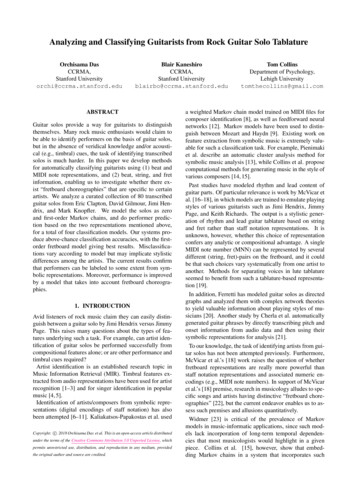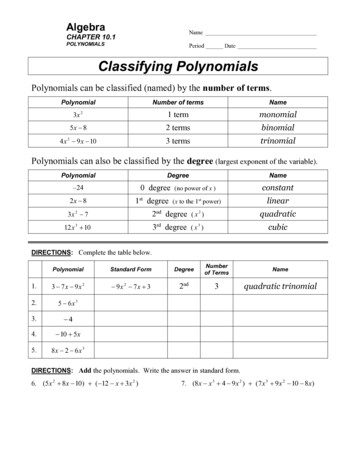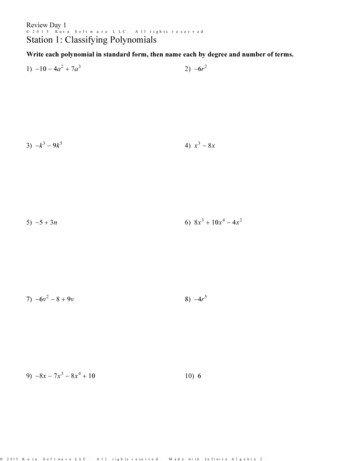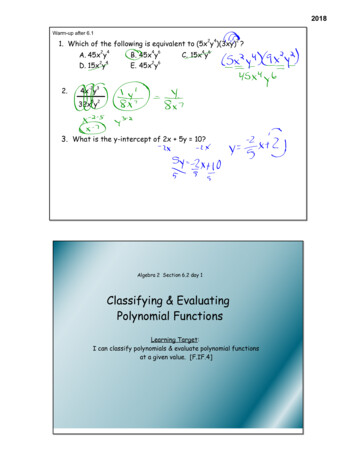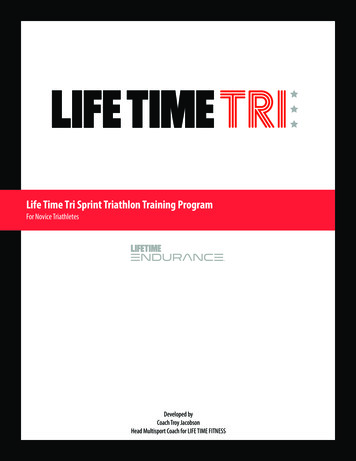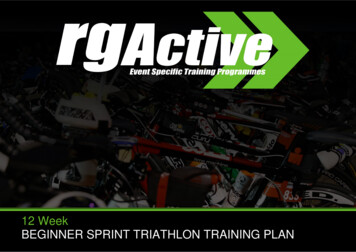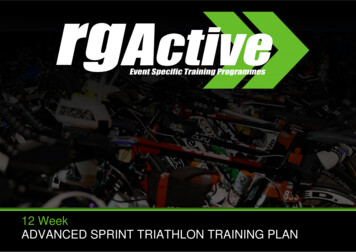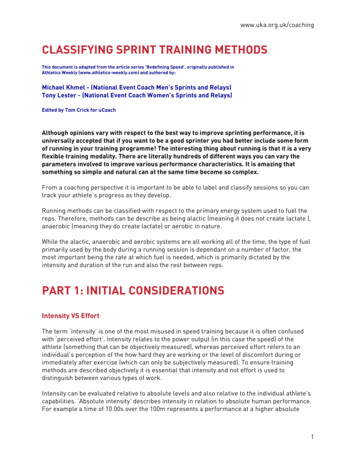
Transcription
www.uka.org.uk/coachingCLASSIFYING SPRINT TRAINING METHODSThis document is adapted from the article series ‘Redefining Speed’, originally published inAthletics Weekly (www.athletics-weekly.com) and authored by:Michael Khmel - (National Event Coach Men’s Sprints and Relays)Tony Lester - (National Event Coach Women’s Sprints and Relays)Edited by Tom Crick for uCoachAlthough opinions vary with respect to the best way to improve sprinting performance, it isuniversally accepted that if you want to be a good sprinter you had better include some formof running in your training programme! The interesting thing about running is that it is a veryflexible training modality. There are literally hundreds of different ways you can vary theparameters involved to improve various performance characteristics. It is amazing thatsomething so simple and natural can at the same time become so complex.From a coaching perspective it is important to be able to label and classify sessions so you cantrack your athlete’s progress as they develop.Running methods can be classified with respect to the primary energy system used to fuel thereps. Therefore, methods can be describe as being alactic (meaning it does not create lactate ),anaerobic (meaning they do create lactate) or aerobic in nature.While the alactic, anaerobic and aerobic systems are all working all of the time, the type of fuelprimarily used by the body during a running session is dependant on a number of factor, themost important being the rate at which fuel is needed, which is primarily dictated by theintensity and duration of the run and also the rest between reps.PART 1: INITIAL CONSIDERATIONSIntensity VS EffortThe term ‘intensity’ is one of the most misused in speed training because it is often confusedwith ‘perceived effort’. Intensity relates to the power output (in this case the speed) of theathlete (something that can be objectively measured), whereas perceived effort refers to anindividual’s perception of the how hard they are working or the level of discomfort during orimmediately after exercise (which can only be subjectively measured). To ensure trainingmethods are described objectively it is essential that intensity and not effort is used todistinguish between various types of work.Intensity can be evaluated relative to absolute levels and also relative to the individual athlete’scapabilities. ‘Absolute intensity’ describes intensity in relation to absolute human performance.For example a time of 10.00s over the 100m represents a performance at a higher absolute1
www.uka.org.uk/coachingintensity than a time of 12.00s. In sprinting, absolute intensity is also linked to the velocityreached during the race so by default 100m races tend to be of a higher absolute intensity than400m races because the top speed reached will be higher. Remember even though the 400m isa ‘harder’ event in terms of effort the absolute intensity is lower – and this is an importantconcept to get to grips with.‘Relative intensity’, on the other hand, relates to the individual’s personal best or currentpotential maximum performance. Under these conditions an athlete’s current season orpersonal best is considered 100% relative intensity. Hence, when an athlete capable of runningten seconds for the 100m takes twenty seconds to cover the same distance the run wasperformed at 50% intensity.An easy way to calculate the relative intensity of a run is to divide the athletes 100%performance by the percentage you want them to be running at. So 90% (0.90) intensity for an11.00s runner will be 11/0.90 12.22s, 80% (0.8) will be 11/0.8 13.75 and so on.The Effect of Intensity on RecoveryIntensity has a significant impact upon recovery. The higher the intensity of the run the longerthe time required to fully recover both between runs and between sessions. The time taken foran athlete to achieve full recovery between training runs is highly individual and may vary from3 to 45 minutes depending on the absolute intensity reached. In the sprints, as a practicalguide, a coach can gauge when an athlete is fully recovered if the next run can be performedin the same or faster time and with the same level of perceived effort. If the athlete is unableto reproduce the previous performance then the rest generally needs to be extended.Since, total relaxation is a prerequisite for high absolute intensities (fast times), high intensityruns will have a low perceived effort by definition (think of Usain Bolt’s World Record run at theBeijing Olympics as an example). However, just because high intensity efforts look ‘easy’ thecoach should not underestimate their impact upon the athlete. Observation by the coaches ofseveral world record holders in the 100m suggest it can take up to two weeks for an athlete tofully recover from such a feat.Unlike other forms of training the effect of high intensity work is not immediately apparent butinstead is delayed, sometimes by several days – in a similar fashion to the way DOMs (DelayedOnset Muscle Soreness) kicks in a day or more after the exercise that stimulated it.The fatigue that occurs as a result of high intensity work cannot be attributed to the build up oflactate, hydrogen ions or other metabolites, due to the fact that very short high intensityworkloads seem to induce it. Instead it is hypothesised to be the result of the loss of the fine coordination required to recruit large numbers of muscle fibres simultaneously and in the desiredorder. Therefore, it is often described as ‘neural’ or ‘Central Nervous System’ (CNS) fatigue.CNS fatigue is not always noticeable during normal everyday activities but instead manifestsitself during high intensity exercise, where it results in a reduction in performance. Empiricalevidence suggests that the fatigue that accompanies high intensity sprint work takes at least48 hours to diminish. Therefore, a coach should think long and hard before scheduling highintensity sessions on consecutive days.2
www.uka.org.uk/coachingAs previously covered in our discussion of the effect and intensity on fine motor skills, asintensity varies so too do the biomechanics of running. In respect to absolute intensity, thebiomechanics of an athlete running a world record in the 100m (high power output) are quitedifferent to those of an athlete running a world record in the marathon (lower but sustainedpower output). Furthermore, as an individual shifts between runs at varying relative intensitiestheir biomechanics will also change. For example there is considerably more variation invertical displacement of the athlete’s centre of mass during runs at lower intensities. Lookingback at the Beijing Olympics Usain Bolt’s biomechanics were very different during his firstround run of 10.20 when compared to his blistering world record final.Motor learning research tells us that for positive reinforcement of the technique to occur, thebiomechanics used in practice must closely resemble those used in competition. Therefore, toimprove the timing of the muscle firing patterns (inter-muscular co-ordination) experiencedduring competition a sprinter must practice running at close to race pace – or 100% relativeintensity over the desired distance.Research and empirical evidence suggests than when an athlete drops below 95% relativeintensity there is little positive reinforcement of race specific mechanics. Using the calculationexplained earlier, this suggest that an athlete aiming to run 100m in 11.00s would need to run atleast 11.60s to gain positive effects in terms refining the specific mechanics required to pushtheir performance below 11s. However, if you are to spend time training at high intensity youmust make sure you respect the increased recovery requirements and the principle of perfectpractice such work brings with it. In short, you cannot run fast all the time and expect improvedperformance without injury. Instead you must be selective about your use of such work but thisis a topic better addressed in conjunction with discussion on the organisation of training.PART 2: THE CLASSIFICATION OF TRAININGMETHODSOver the years sprint coaches have developed a special vocabulary to describe thecharacteristics of runs of varying durations and intensities. The terms used in this article arefound predominantly in literature from the soviet sporting nations. Although not universallyimplemented by all coaches the following descriptions provide a good terminological basis fromwhich to discuss sprint training and will form the basis of definitions used in the UKA CoachingQualifications. They have also been specifically chosen to align with definitions used in the UKAExercise Classification Hierarchy and other areas of the training literature – specifically thatsurrounding strength training.Due to the link between biomechanics and intensity, work in the intensity zone of 95-100% playsa significant role in a sprinter’s programs. Work of this intensity bracket is collectively referredto as ‘high intensity’ and can be sub classified as Speed, Speed Endurance, Specific Enduranceand Special Endurance. For sprinters competing in distances from 60-400m this high intensitywork is classified under Competitive Exercises in the UKA Exercise Classification Hierarchy.3
www.uka.org.uk/coachingFor more details see the Exercise Classification Hierarchy Document and Podcast on uCoach: lassification-hierarchy-v1.0-document/ cation-hierarchy-podcast/Competitive Exercises: High Intensity TrainingThe UKA Exercise Classification Hierarchy (ECH), was developed to help coaches to organisetheir training by placing all activities into one of four categories depending on the degree towhich an exercise transfers to the event being trained for.Within the ECH, the term ‘Competitive Exercises’ (CE) refers to exercises they are almostidentical to what happens in a race in terms of the mechanics that are used to execute them. Insprinting the CE category includes all the forms of sprinting that take place at near maximalintensity – e.g. Speed, Speed Endurance, Specific Endurance and Special Endurance work.SPEED WORKThe term ‘Speed work’ describes runs of near maximal intensity (95-100%) carried out underalactic conditions, that is under conditions where lactic acid levels in the muscles are minimaland ATP-CP (also known as the phosphagen system) is the key energy system being utilised topower activity. As a rule of thumb, runs of near maximal intensity will remain alactic if they donot exceed around seven seconds in duration and if full recovery is permitted betweenconsecutive runs. To ensure the athlete learns to run with perfect technique, when perceivedeffort increases a speed session should be ended or poor practice will be reinforced.When considering what is and what isn’t speed work for your athlete, it is important to note thatan athlete’s performance level plays a big part in determining what can be achieved via alacticmeans. Highly qualified (e.g. international) athletes will be able to run further before the runstops being alactic and consequently can use longer distances than novices. However, thehigher absolute intensity will require them to take longer rest breaks between runs if they wishto reproduce their previous performance (because they have activated more muscle mass toachieve the higher performance).Defining Full RecoveryFor the record, ‘full recovery’ in the context of inter rep or set rest means a rest interval that islong enough for the athlete to be capable of performing the next repetition in the same time orfaster than the last. While research shows that ATP-CP is fully restored by the body in aroundthree minutes common sense tells us that an athlete is not necessarily fully recovered from aseven second effort (say a 60m race) in three minutes, so the coach must exercise their bestjudgement as to what is an appropriate ‘full recovery’ for a run of a given distance at highintensity. As a rule of thumb, for every second spent sprinting the athlete should rest one to twominutes in order to fully recover. So a five second effort will usually requires between five to tenminutes rest. Within this range, ten minutes would be more appropriate for elite athletes, whileyounger developing athletes may be able to use less than five.4
www.uka.org.uk/coachingTypes of Speed WorkSince speed work encompasses alactic high intensity activity it incorporates both technical workfor acceleration and for maximum velocity mechanics. Hence, there are essentially three kindsof sessions that fall under the ‘speed’ category: Short acceleration runs (acceleration focus)Flying runs (maximum velocity focus)Runs from a stationary start over varying distances where the total duration of the run is 7s or less(race modelling focus – where the aim is to practice the first part of the event)The aim of work of this nature is to perfect acceleration and top speed mechanics whileexpanding an athlete’s ability to perform work under alactic conditions (that is workpredominantly fuelled by ATP-CP).This last point about expanding an athlete’s alactic capacity is an important concept in thesprints. Most coaches are familiar with the idea of improving an athlete’s anaerobic capacityand ability to deal with the build up of lactic acid within the muscles, often described asdeveloping an athlete’s ‘lactic tolerance’. Lactic tolerance is easy for a coach to assess becauseyou can see a huge difference between an athlete that is used to lactic work compared to thosewho are not. The key changes after training for ‘lactic tolerance’ will be a longer time until theathlete is severely affected by the accumulation of lactic and reduced perceived effort duringanaerobic training sessions. The same concept also applies to the development of ‘alacticcapacity’, where an athlete who is used to speed work will find they can do more volume ofspeed work be
CLASSIFYING SPRINT TRAINING METHODS This document is adapted from the article series ‘Redefining Speed’, originally published in Athletics Weekly (www.athletics-weekly.com) and authored by: Michael Khmel - (National Event Coach Men’s Sprints and Relays) Tony Lester - (National Event Coach Women’s Sprints and Relays)


